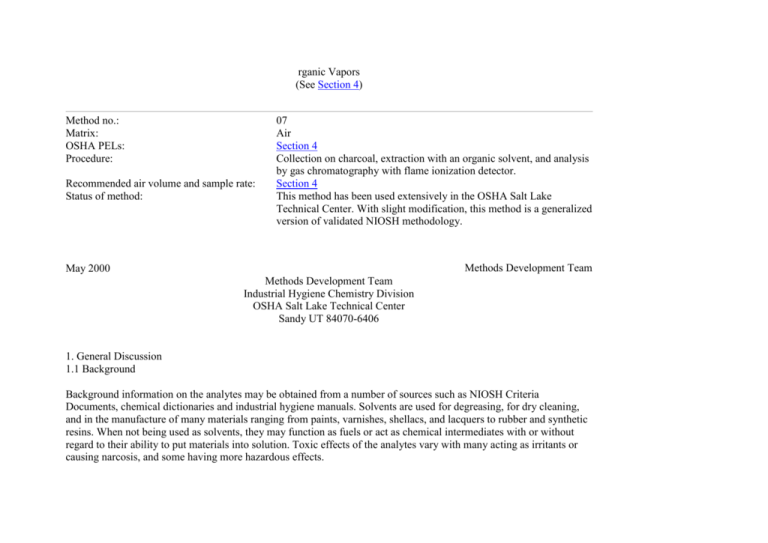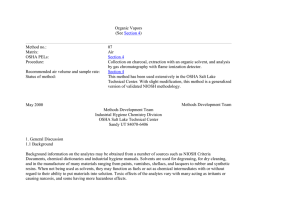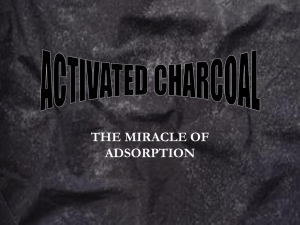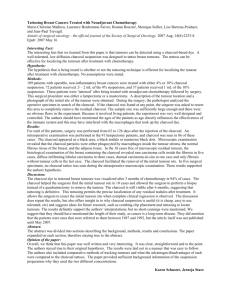rganic Vapors (See Section 4) Method no.: 07 Matrix: Air OSHA
advertisement

rganic Vapors (See Section 4) Method no.: Matrix: OSHA PELs: Procedure: Recommended air volume and sample rate: Status of method: 07 Air Section 4 Collection on charcoal, extraction with an organic solvent, and analysis by gas chromatography with flame ionization detector. Section 4 This method has been used extensively in the OSHA Salt Lake Technical Center. With slight modification, this method is a generalized version of validated NIOSH methodology. Methods Development Team May 2000 Methods Development Team Industrial Hygiene Chemistry Division OSHA Salt Lake Technical Center Sandy UT 84070-6406 1. General Discussion 1.1 Background Background information on the analytes may be obtained from a number of sources such as NIOSH Criteria Documents, chemical dictionaries and industrial hygiene manuals. Solvents are used for degreasing, for dry cleaning, and in the manufacture of many materials ranging from paints, varnishes, shellacs, and lacquers to rubber and synthetic resins. When not being used as solvents, they may function as fuels or act as chemical intermediates with or without regard to their ability to put materials into solution. Toxic effects of the analytes vary with many acting as irritants or causing narcosis, and some having more hazardous effects. 1.2 Statistical parameters 1.2.1 Each analyte included in this general procedure has a validated NIOSH method, (Ref. 5.1) and/or a validated OSHA method. One of the NIOSH validation requirements is that the results obtained be within ±25% of the true values at the 95% confidence level at the air concentration equal to the OSHA standard. Although the OSHA evaluation procedure differs from that of NIOSH, the same validation requirements are used. 1.2.2 Refer to the validated NIOSH methods, (Ref. 5.1) for detailed information on individual analytes. 1.3 Advantages 1.3.1 The sampling device is small, portable, and involves no liquids. 1.3.2 The analysis is by a quick instrumental method. 1.3.3 Interferences can be eliminated by altering chromatographic conditions in most cases. 1.3.4 The method allows simultaneous analysis of two or more analytes. 1.4 Disadvantages 1.4.1 The air volume sampled is limited by the capacity of the charcoal tubes. Exceeding the capacity of the charcoal tube results in loss of sample. The adsorptive capacity is decreased by high humidity. 1.4.2 The method is limited by the reproducibility of the pressure drop across the tubes. The pressure drop affects the flow rate causing the air volume to be imprecise. 1.4.3 The analyst must work with toxic solvents. 1.4.4 When many components are present, elimination of interferences becomes difficult. 2. Sampling Procedure 2.1 Apparatus 2.1.1 A calibrated personal sampling pump whose flow can be determined within ±5% at the recommended flow rate with the sampling device attached. 2.1.2 Charcoal tubes: Glass tubes with both ends flame sealed, 7 cm long with a 6-mm o.d. and 4-mm i.d., containing two sections of 20/40 mesh activated charcoal separated by a 2-mm portion of urethane foam. The activated charcoal is prepared from coconut shells and is fired at 600°C prior to packing. The adsorbing section contains 100 mg of charcoal, the backup section 50 mg. A3-mm portion of urethane foam is placed between the outlet end of the tube and the backup section. A plug of silylated glass wool is placed in front of the absorbing section. The pressure drop across the tube must be less than 1 in. of mercury at a flow rate of 1 L/min. 2.1.3 Certain analytes require petroleum base charcoal instead of coconut base charcoal. This requirement is specified in Section 4. 2.2 Reagents None required in sampling procedure. 2.3 Technique 2.3.1 Immediately before sampling, break the ends of the tube to provide an opening at least one-half the internal diameter of the tube (2 mm). 2.3.2 The smaller section of charcoal is used as a backup and should be positioned nearest the sampling pump. 2.3.3 The charcoal tube should be placed vertically during sampling to minimize channeling. 2.3.4 Air being sampled should not be passed through any hose or tubing before entering the charcoal tube. 2.3.5 Do not exceed the recommended air volume. 2.3.6 The charcoal tubes should be capped with the supplied plastic caps immediately after sampling. Under no circumstances should rubber caps be used. 2.3.7 One tube should be handled in the same manner as the sample tube (break, seal and transport) except that no air is sampled through this tube. This tube should be labeled as a blank. 2.3.8 Capped charcoal tubes should be wrapped end to end with official OSHA seals. They should be packed tightly and padded before they are shipped to minimize tube breakage during shipping. 2.3.9 For certain analytes where migration on the charcoal is a significant problem, it may be requested that two charcoal tubes be used in series in order that breakthrough may be distinguished from migration. These tubes must be separated and individually capped and sealed before shipping. 2.4 Breakthrough Breakthrough data is presented on each analyte in its respective validated NIOSH method (Ref. 5.1). 2.5 Extraction efficiency 2.5.1 The back end of a charcoal tube is opened and the backup portion of activated charcoal is removed, leaving the front 100-mg portion of activated charcoal intact in the tube. The activated charcoal must be of the same lot as that in the tubes used to collect the samples. A known amount of analyte is injected directly into the activated charcoal with a microliter syringe and the tube is capped. 2.5.2 Six tubes at each of three concentration levels (0.5, 1, and 2 times the standard) are prepared by adding an amount of analyte equivalent to that present in a recommended air sample at the selected level. The tubes are allowed to stand at least overnight to assure complete adsorption of the analyte onto the charcoal. These tubes are referred to as the samples. A parallel blank tube should be treated in the same manner except that no analyte is added to it. The sample and blank tubes are extracted and analyzed in exactly the same manner as the sampling tube described in Section 3. 2.5.3 The extraction efficiency (EE) equals the average weight in milligrams recovered from the tube divided by the weight in milligrams added to the tube, or MR EE = MS where: EE is extraction efficiency MR is mass recovered MS is mass spiked 2.5.4 If there is a significant change in extraction efficiency over the range of loadings studied, a plotted curve of EE versus mass recovered must be used to correct for adsorption losses. 2.5.5 If there is no significant change in EE over the range studied, reconfirmations need only be carried out at one loading in the middle of the range. 2.6 Recommended air volume and sample rate See Section 4. for recommended air volume and sampling rate. 2.7 Interferences 2.7.1 It is important to be aware of other components in the atmosphere which may interfere with the collection of the analyte. 2.7.2 High relative humidity may significantly affect the collection of some analytes. 2.8 Safety precautions 2.8.1 Care must be taken when opening the sealed ends of charcoal tubes to avoid cuts to the hands. 2.8.2 Safety glasses should be worn when opening the sealed ends of charcoal tubes to avoid injury to the eyes from glass splinters. 3. Analytical procedure 3.1 Apparatus 3.1.1 Gas chromatograph equipped with flame ionization detector. 3.1.2 Columns. A variety of columns are suitable. Two good selections are a 60-m × 0.32 mm DB-1 capillary column with 1m df or a 60-m × 0.32 mm DB-Wax capillary column with 1 µm df. Similar columns from other manufactures are acceptable. 3.1.3 A suitable method of measuring peak areas, such as an electronic integrator or data system. 3.1.4 Two-milliliter vials with either screw-on or crimp-on caps which contain PTFE-lined septa. 3.1.5 Microliter syringes; one-microliter for GC injections and 10-µL for standard preparation, or other suitable sizes. 3.1.6 Pipets for dispensing extracting solvent (ES). A Glenco 1-mL reagent dispenser is adequate and convenient. 3.1.7 Volumetric Flasks. Five-milliliter and other convenient sizes. 3.1.8 Glass tubing cutter. 3.2 Reagents 3.2.1 Chromatographic quality extracting solvent (ES). Although carbon disulfide is commonly used as the ES, certain analytes can be more effectively extracted with the use of alternate solvents or solvent solutions. These alternate ESs are listed in Chemical Sampling Information located at http://www.osha.gov and are normally used when the single analyte is requested or when the requested analytes are known to be effectively extracted with that ES. When analysis for a number of analytes requiring different extracting solutions is requested, the preferred ES will usually be carbon disulfide. 3.2.2 Analyte standard, reagent grade. 3.2.3 Internal standard, (optional) reagent grade. p-Cymene and n-hexylbenzene are suitable internal standards for many solvents. 3.2.4 Chromatographic quality helium, nitrogen, hydrogen, and air. 3.3 Standard preparation 3.3.1 Prepare analyte standard at a concentration of 1 µL of analyte per milliliter of ES by adding 5 µL of analyte to a 5-mL volumetric flask partially filled with ES. Fill the volumetric flask to the mark and invert 3 or 4 times for proper mixing. Other size volumetric flasks may also be used to prepare the 1 µL/mL analyte standards. At least two standards at 1 µL/mL are prepared. Standards must be used the day they are prepared. In some cases, analyte standards in concentrations other than 1 µL/mL may be more suitable, especially with analytes that have extremely high or low OSHA standards. 3.3.2 Injection of standards is accomplished with a 1-µL or other suitable syringe. The syringe is rinsed thoroughly in carbon disulfide between standards. Injector septa should be checked for wear daily. 3.3.3 Injection sizes other than 1-µL and injection by means of a gas chromatograph autosampler are acceptable in most cases. 3.4 Preparation of samples 3.4.1 The status of the seals on each charcoal tube is noted and recorded as intact, broken, or none. 3.4.2 The field identification number, the laboratory identification number and signature of the industrial hygienist on each sample seal are checked with those on the sample identification sheets. 3.4.3 The seal is removed and the charcoal tube is opened with a glass tubing cutter at the end containing the larger portion of charcoal. The front and back sections of charcoal are transferred to separate 2-mL capped vials. The glass wool plug and the small wad of urethane foam separating the two sections of charcoal are discarded. 3.4.4 The charcoal lot number is noted in order that the proper extraction efficiency is used in later calculations. 3.4.5 Gas chromatography parameters are set as recommended in the instruments manual. Oven temperature and column are varied until an optimum chromatogram is produced by the analyte standard. 3.4.6 Once the internal standard has been verified as not interfering with other peaks in the chromatogram, the samples are extracted. One milliliter of ES is dispensed into each sample vial. The vial is immediately sealed. Each vial is swirled periodically to increase the rate of extraction. Twenty to thirty minutes is typical for the extraction process. 3.5 Analysis 3.5.1 The data processor can be calibrated to provide results directly in units of mass. With a few of the analytes an additional similar correction may be necessary due to extraction efficiencies that change with concentration. The linear nature of the flame ionization detector allows the use of a point calibration, but the bracketing of samples with analytical standards is a good practice. The calculation of the equivalent air concentration for an analytical standard is detailed in Section 3.7.1. 3.5.2 Sample injection is accomplished with a 1-µL or other suitable syringe. The syringe is rinsed thoroughly in carbon disulfide between samples. Injector septa should be checked for wear periodically. Injection by means of a gas chromatograph autosampler is acceptable. 3.5.3 Bracket the samples with analytical standards if detected concentrations are above the PEL. 3.5.4 When the identity of a suspected analyte peak is in question, it should be confirmed by GC/MS, GC/IR, or by retention time on at least two GC columns containing different packing material. The identity of the analyte should be considered suspect when detected concentrations are above the PEL. 3.6 Interferences Interferences to the analytical method will in most cases appear as poor resolution of the analyte peak from other components. This may be overcome by prudent selection of a more suitable chromatographic condition or column. 3.7 Calculations 3.7.1 An equivalent air concentration for analytical standards is used to calibrate the data processor such that analytical results are obtained directly in mass, mg. W = VS × d where: W is weight of analyte in µg VS is volume of analyte in µL d is density of analyte in µg/µL VMW CV = MrVEE where: CV VM W Mr V EE is air concentration reported to IH is molar volume at 25°C and 760 mmHg, 24.46 L/mol is weight of analyte is molecular weight of the analyte is air volume sampled is extraction efficiency 3.7.2 The following example is the calculation for toluene: W = 867 µg = 1 µL × 867 µg/µL (24.46 L/mol)(867 µg) CV = 23.73 ppm = (92.15 g/mol)(10 L)(0.97) The calculations should be considered an example only, and various parameters confirmed before used in actual analysis. 3.8 Safety precautions 3.8.1 Care must be taken when opening charcoal tubes to avoid cuts to the hands. 3.8.2 Safety glasses must be worn throughout the analytical procedure. 3.8.3 Work involving solvents open to the atmosphere must be performed in a hood. 3.9 Reporting results 3.9.1 When results uncorrected for air volume are greater than 10 ppm, three significant digits will be reported. For results below 10 ppm, the chemist will use his judgment, but in no cases report more than three significant digits. 3.9.2 The estimated detection limit based on the lowest mass per sample injected as a standard. 3.9.3 All concentration levels down to the detection limit are reported. 3.9.4 If the concentration of analyte found on the back section of the charcoal tube is equal to or greater than 25% of the concentration found on the front section, the charcoal tube is considered to be saturated and reported as such on the analyst worksheet. 3.9.5 The presence of significant peaks caused by unrequested components in the sample is noted on the analyst worksheet and they are identified and quantitated if possible. 3.9.6 All data processor print-outs and chart recorder chromatograms are filed in a central file according to laboratory sample identification number. 3.9.7 Analytical data and results are checked by a fellow chemist before the completed analyst worksheets are given to the team leader. 4. Analytes The following table contains those analytes which can be analyzed by this procedure. Standard size charcoal tubes containing coconut base charcoal are used unless specified otherwise in the table. Listed PELs are 8-h time weighted averages unless denoted as a ceiling concentration with a "(C)", before the PEL value. Before taking samples, the OSHA Chemical Sampling Information at http://www.osha.gov should be consulted for additional and more detailed information. Table 4. Recommended Sampling Parameters for Analytes Covered by This Procedure. ANALYTE PEL (ppm) air vol (L) max rate NIOSH (L/min) Method Allyl alcohol 2 10 0.2 1402 Allyl chloride 1 48 0.2 1000 n-Amyl acetate 100 10 0.2 1450 sec-Amyl acetate 125 10 0.2 1450 Benzyl chloride 1 10 0.2 1003 Bromoform 0.5 10 0.2 1003 Butyl acetate 150 10 0.2 1450 sec-Butyl acetate 200 10 0.2 1450 tert-Butyl acetate 200 10 0.2 1450 Butyl alcohol 100 10 0.2 1401 sec-Butyl alcohol 150 10 0.2 1401 tert-Butyl alcohol 100 10 0.2 1400 n-Butyl glycidyl ether (BGE) 50 10 0.2 1616 p-tert-Butyltoluene 10 24 0.2 1501 Camphor 2 mg/m3 24 0.2 1301 Carbon tetrachloride 10 15 0.2 1003 Chlorobenzene (monochlorobenzene) 75 10 0.2 1003 Chlorobromomethane 200 5 0.2 1003 Cumene 50 10 0.2 1501 Cyclohexane 300 5 0.2 1500 Cyclohexanol 50 10 0.2 1402 Cyclohexene 300 5 0.2 1500 Diacetone alcohol (4-hydroxy-4-methyl-2pentanone) 50 10 0.2 1402 o-Dichlorobenzene (C)50 3 0.2 1003 p-Dichlorobenzene 75 0.05 1003 1,1-Dichloroethane 100 10 0.2 1,2-Dichloroethylene 200 3 0.2 1003 Dichloroethyl ether (C)15 15 1.0 1004 1,1-Dichloro-1-nitroethane** (C)10 15 1.0 1601 Difluorodibromomethane(F-12-B2)* 100 10 0.2 1012 Diisobutyl ketone 50 10 0.2 1300 Dioxane (diethylene dioxide) 100 10 0.2 1602 Epichlorohydrin 5 20 0.2 1010 Ethyl acetate 400 6 0.2 1457 Ethyl sec-amyl ketone (5-methyl-3-heptanone) 25 25 0.2 1301 Ethyl bromide 200 4 0.2 1011 Ethyl butyl ketone (3-heptanone) 50 25 0.2 1301 Ethylene chlorohydrin** 5 35 0.2 2513 Ethyl ether 400 3 0.2 1610 Ethyl formate 100 10 0.2 1452 Glycidol (2,3-epoxy-1-propanol) 50 50 1.0 1608 n-Heptane 500 4 0.2 1500 Hexachloroethane 1 10 0.2 1003 n-Hexane 500 4 0.2 1500 2-Hexanone (MBK) 100 10 0.2 1300 sec-Hexyl acetate 50 10 0.2 1450 Isoamyl acetate 100 10 0.2 1450 Isoamyl alcohol 100 10 0.2 1402 Isobutyl acetate 150 10 0.2 1450 Isobutyl alcohol 100 10 0.2 1401 Isophorone** 25 12 0.2 2508 Isopropyl acetate 250 8 0.2 1454 Isopropyl ether 500 3 0.05 1618 Isopropyl glycidyl ether 50 10 0.2 1620 Mesityl oxide 25 25 0.2 1301 Methyl acetate 200 7 0.2 1458 Methylal (dimethoxymethane) 1000 2 0.2 1611 Methyl-(n-amyl)ketone 100 25 0.2 1301 Methylcyclohexane 500 4 0.2 1500 Methyl isobutyl carbinol 25 10 0.2 1402 α-Methyl styrene (C)100 3 0.2 1501 Octane 500 4 0.1 1500 Pentane 1000 2 0.05 1500 2-Pentanone 200 10 0.05 1300 Phenyl glycidyl ether 10 50 0.1 1619 n-Propyl acetate 200 10 0.2 1450 Propyl alcohol 200 10 0.2 1401 Propylene dichloride 75 10 0.2 1013 n-Propyl nitrate** 25 70 0.1 S227 1,1,1,2-Tetrachloro-2, 2-difluoroethane 500 2 0.035 1016 1,1,2, 2-Tetrachloro-1, 2-difluoroethane 500 2 0.035 1016 1,1,2,2-Tetrachloroethane** 5 10 0.2 1019 Tetrahydrofuran 200 5 0.2 1609 Tetramethyl succinonitrile 0.5 48 0.2 S155 1,2,3-Trichloropropane 50 10 0.2 1003 Vinyl toluene 100 24 0.2 1501 *Use two charcoal tubes in series for sampling. **Use petroleum base charcoal for sampling. 5. References 5.1 "NIOSH Manual of Analytical Methods", ed. 4 Vol. 1-3 National Institute of Occupational Safety and Health, U.S. Government Printing Office, Washington, D.C. (1998)







